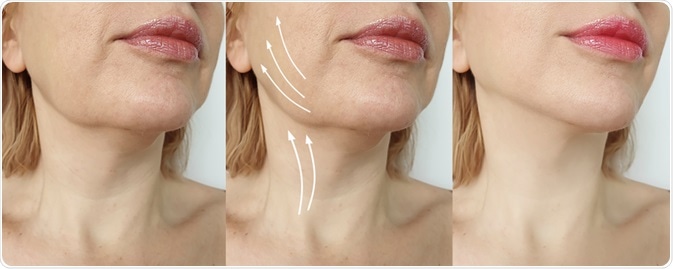A facelift surgery, also known as rhytidectomy, is one of the most coveted plastic surgery operations in the world. This procedure is performed to improve the physical signs of aging, which occurs as a natural process.
As humans age and lose their youthful appearance, the toll of time shows on their faces. The fine expression marks on the forehead, for instance, gradually evolve into marked creases, ultimately becoming deeper folds. The once tight jawline becomes softer and sags, which gives people what is colloquially referred to as a ‘turkey neck’ or double chin.

Image Credit: Julenochek / Shutterstock.com
There is no escaping the factors that contribute to the natural process of facial aging. These include a genetic predisposition that combines with elements such as gravity’s pull, solar exposure, and personal habits, to determine how gracefully or not humans will age.
The facelift surgery is done to reverse the marks of time. However, it cannot entirely stop the process of aging and the surgery itself will not alter one’s fundamental appearance. Surgery is the only route to achieve desired results; however, it may be complemented with non-surgical treatments to rejuvenate the face.
Pre-surgical assessment
Before a facelift can be done, there are several factors that must be taken into consideration. First and foremost, patients must be suitable candidates for the operation. This means that a patient should have good overall health, well-defined facial bones, supple and flexible skin, as well as realistic expectations of the surgical outcomes.
Skin elasticity is important, as skin is tightened during the procedure to minimize wrinkling. An underlying bone structure that is well-defined is necessary for satisfactory results. Most importantly, candidates for the operation should fully understand the limitations associated with the surgery so that they do not have impractical expectations.
In planning the procedure, the surgeon determines what type of anesthesia will be used in addition to the locations where incisions will be made. If the patient smokes, cessation is strongly advised for at least one or two weeks prior to the surgery and a week or two thereafter.
Types of facelifts
Together with the patient, surgeons will determine the type of facelift that will be used. Traditional facelifts typically offer results that are the most comprehensive and target a larger area of the face and neck. The incisions are therefore longer and are popular in patients in their fifth and sixth decades of life.
In contrast to traditional full facelifts, mid-facelifts are done to target tissues around the cheeks and eyes, with deeper incisions that are used to reach muscles that are not touched during a traditional lift. Moreover, mid-facelifts are more suitable for younger patients seeking a simple rejuvenation, as this type of procedure does not address all of the typical signs of aging.
Mini- or weekend facelifts target very small areas, which are mostly the neck, lower cheeks, or jaw, and are more popular among younger patients. Lower facelifts are done on the lower third of the face, whereas thread facelifts are minimally invasive alternatives to full facelifts. Thread facelifts involve very small incisions to lift underlying facial muscles.
Techniques
There are many different techniques that may be utilized to achieve the various types of facelifts. Endoscopic approaches may be used for all types of facelifts, especially those which involve smaller areas. Endoscopic facelifts require the use of small incisions with the help of a camera and operating tools.
Cutaneous facelifts are another type of technique, which is among the oldest techniques, and are done primarily to correct sagging and remove excess skin. Cutaneous techniques have been largely replaced by superficial musculoaponeurotic system (SMAS) facelifts, which are more comprehensive and achieve more natural-looking results.
Difference between a minifacelift and a full facelift? Shapiro Plastic Surgery, AZ
Another type of facelift technique is the S-lift, during which an incision in the form of an S is made near the ear. The results of this procedure are not as great as other techniques; however, it is associated with reduced costs and a faster recovery time. S-lifts are also typically used to sculpt the lower face and the jaw.
A deep plane facelift is another type of technique that is used to reach layers that the SMAS technique will not. Moreover, the deep plane facelift must be performed by highly equipped and qualified surgeons, as there is a greater risk of nerve damage. Even deeper tissues can be reached with subperiosteal facelifts, although the primary goal of this procedure, like other types of facelifts, is to treat sagging skin and remove excess skin.
Post-surgery

Image Credit: TanyaLovus / Shutterstock.com
Following the surgery, there is some pain, which is usually minimal, as well as some bruising and swelling. Keeping the head elevated, together with the application of cold compresses, will reduce the swelling. There are very few complications with regards to facelift surgery; however, like any other surgery, there are certain risks that patients should be aware of.
Sutures are usually removed within a week; however, recovery time may take up to three weeks. Scars are hardly noticeable with the passage of time. If done masterfully, the facelift will result in an appearance that is as naturally beautiful as possible without any obvious signs of the surgery.
References
Further Reading
Last Updated: May 13, 2021